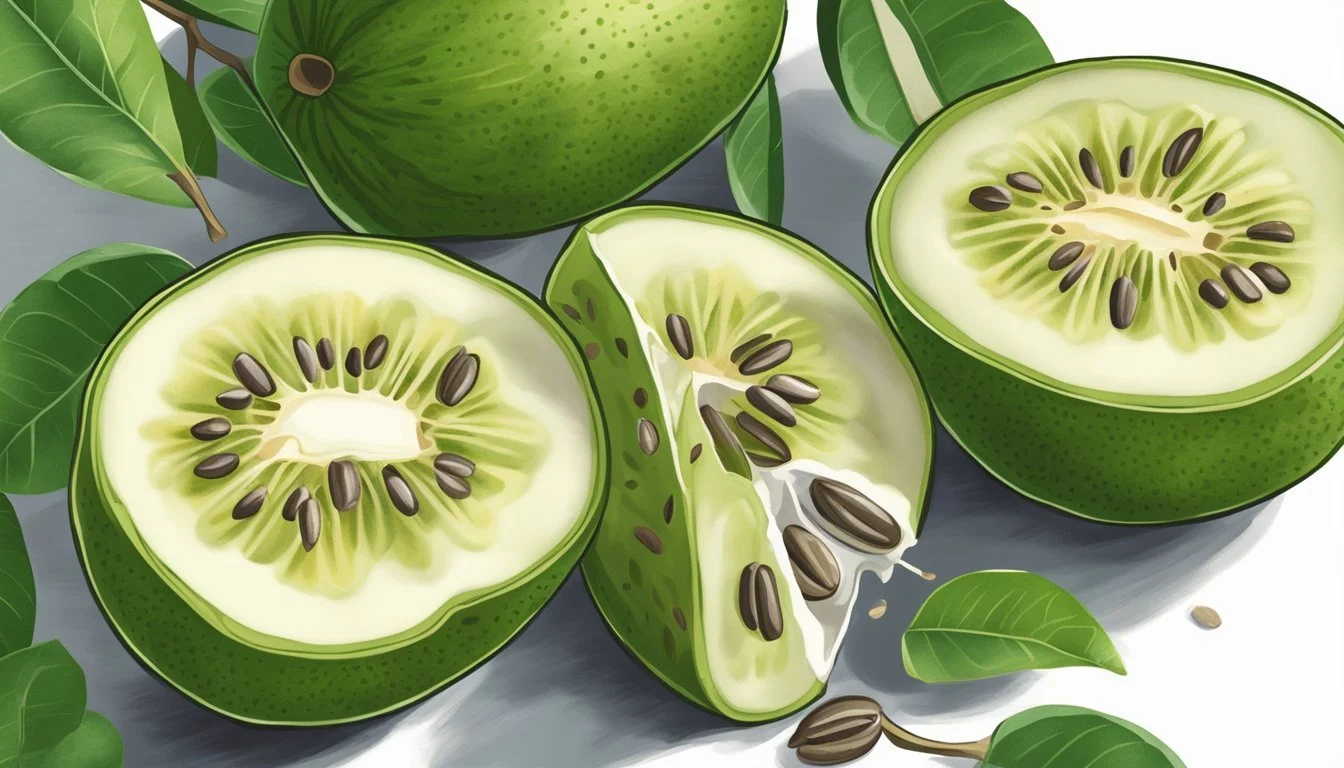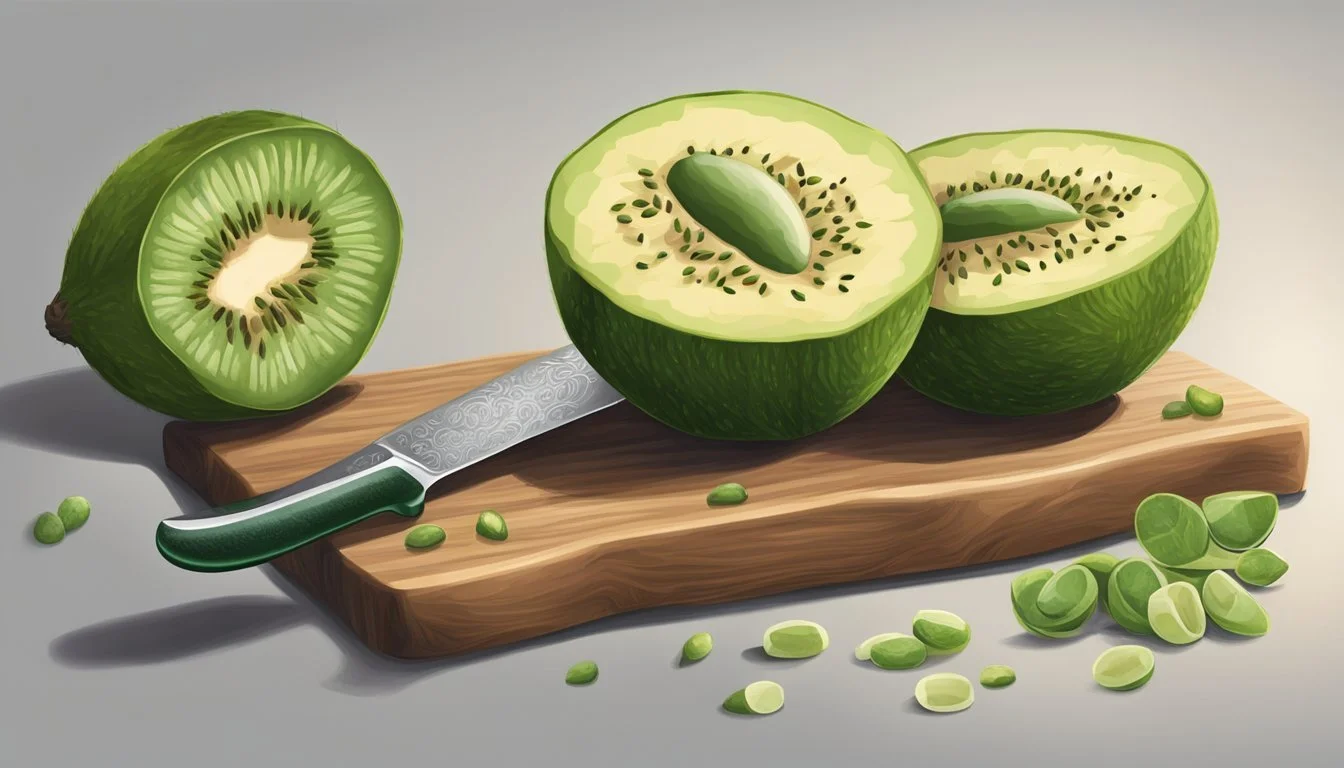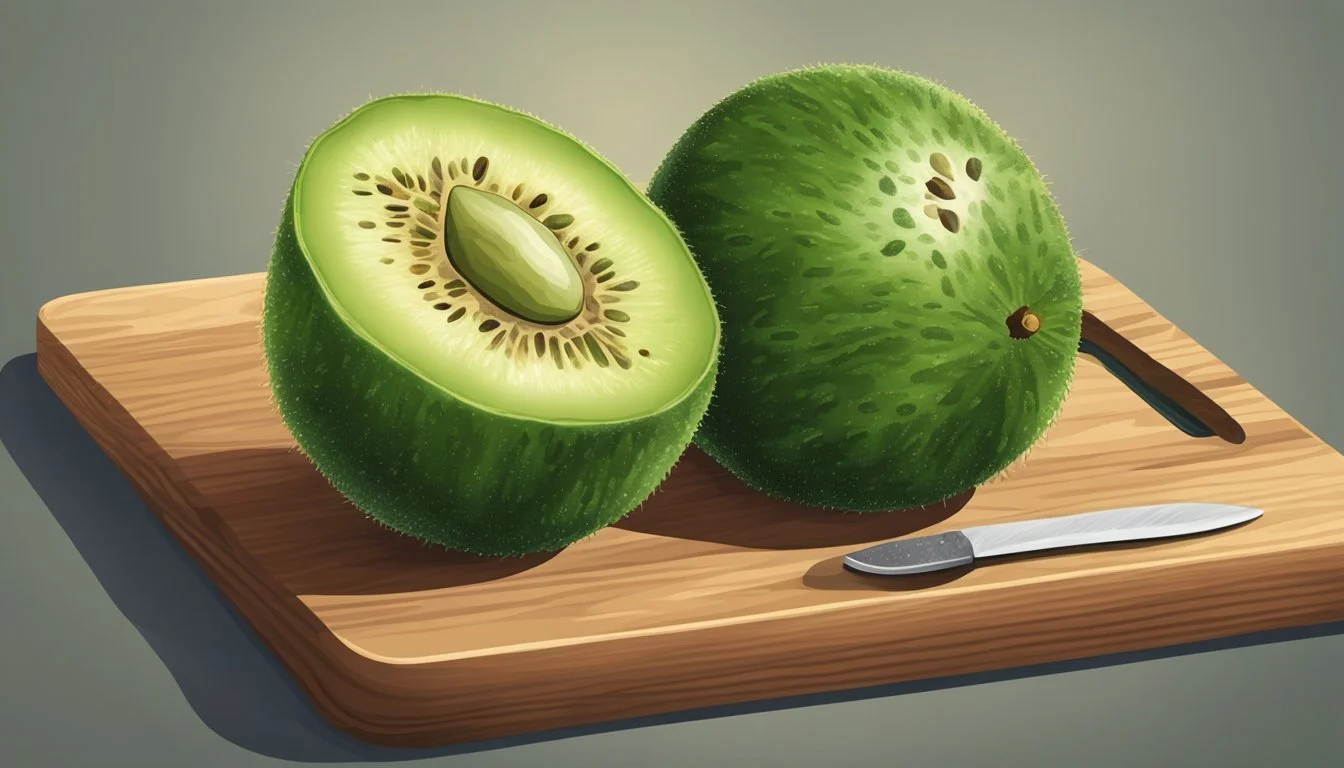How Do You Eat a Feijoa?
Unveiling the Simple Steps
Feijoas, also known as pineapple guavas, are unique fruits that hail from South America and have gained popularity across the globe for their distinctive flavor and health benefits. These green, egg-sized fruits have a sweet taste with a hint of tartness and aroma that is reminiscent of pineapple, apple, and mint. They can be a delightful addition to a variety of dishes or simply enjoyed on their own.
To enjoy a feijoa, it is commonly recommended to slice the fruit in half, and then scoop out the succulent flesh with a small spoon. The flesh is juicy and the center contains slightly gritty elements similar to a pear, adding texture to the experience. One can eat feijoas fresh from the tree or incorporate them into breakfast cereals, smoothies, and desserts to add a sweet and aromatic flavor. It's important to choose feijoas that are ripe, which typically feel slightly soft to the touch, much like choosing a ripe avocado.
When preparing a feijoa, it is essential to avoid the bitter, acrid lining of the skin. Eating feijoas is not only an enjoyable experience but also beneficial to one's diet. These fruits are high in fiber and vitamin C, supporting digestion and immune health. Their richness in fiber also contributes to a feeling of fullness, assisting in weight management strategies. Due to their unique flavor profile and health properties, feijoas have become a favored fruit among those looking to diversify their culinary palate.
Identifying Ripe Feijoas
Ripe feijoas are essential for enjoying the full flavor and sweetness of the fruit. Recognizing when a feijoa is ready to eat involves assessing color, texture, and aroma for optimal ripeness.
Color and Texture
When choosing a feijoa, one should look for a fruit that has a green hue, but not overly bright. The skin should be smooth and free from excessive blemishes or bruising. As the fruit matures, the green may become slightly duller which is an indicator of ripeness. A ripe feijoa may exhibit a slight softness to touch, similar to that of a ripe avocado, giving in gently under pressure.
Smell and Firmness
The aroma of a ripe feijoa is a reliable guide. A fragrant, sweet smell, especially around the stem end, suggests the fruit is ripe and ready to consume. In terms of firmness, a ripe feijoa should give slightly when pressed near the stem. This softness indicates that the feijoa is at the peak of its ripeness and will detach easily if still on the tree. If the fruit resists or feels hard, it may require additional time to ripen.
Basic Consumption Methods
Feijoas can be enjoyed in several straightforward ways that make the most of their unique taste and texture. The flesh of the fruit is the edible part, and there are methods that can enhance your feijoa eating experience.
Cutting and Slicing
To eat a feijoa, one can first slice the fruit into halves or quarters. This allows for easy access to the aromatic flesh inside. With the fruit cut open, one can either consume the slices as they are or cut the flesh further into smaller pieces for adding to dishes such as salads or cereals.
Halves: Slice the feijoa in half, across the middle.
Quarters: Further slice each half into two, if a smaller portion is preferred.
Spoon Method
An alternative and very popular method to consume feijoas is by using a spoon to scoop out the flesh. This method minimizes waste and is a quick way to enjoy the fruit.
Steps:
Slice the fruit in half.
Scoop the flesh with a small spoon.
Eating feijoas using the spoon method ensures that one enjoys the whole fruit without the need for additional utensils or preparation.
Advanced Eating Techniques
For individuals looking to enhance their feijoa consumption experience, advanced eating techniques offer innovative and flavorful methods to enjoy this unique fruit. These techniques concentrate on savoring the fruit while employing its distinct texture and taste effectively.
Squeeze and Eat
One may harness the ripe texture of a feijoa to one's advantage by simply using the "squeeze and eat" method. When a feijoa is ripe, its skin has a slight give to gentle pressure. To enjoy the fruit:
Assess Ripeness: Gently squeeze the feijoa; the skin should yield about 2mm for ripeness.
Squeeze Method: Apply gentle pressure until the fruit begins to crack open.
Enjoy: Bring the fruit to your mouth and gently squeeze again, consuming the soft, scooped-out flesh directly.
This technique allows the eater to relish the fruit without the need for utensils, providing a quick and direct way to savor a ripe feijoa.
Peel and Bite
For those who prefer a more hands-on approach:
Peel the Skin: Carefully peel the feijoa skin off the fruit, which should come away easily if the feijoa is ripe.
Bite and Savor: Take a bite directly into the flesh of the fruit.
This method gives the eater the full experience of the feijoa's texture and taste, allowing for a deeper appreciation of the fruit's soft inner pulp contrasted with its slightly firmer outer flesh. It's a tactful way to enjoy a feijoa without losing any of its flavors or wasting its edible parts.
Culinary Uses for Feijoas
Feijoas, with their unique flavor profile, are a versatile ingredient that can be incorporated into a wide range of dishes from sweet desserts to hearty savory plates, and refreshing beverages.
Feijoa Desserts
In the realm of desserts, feijoas are commonly used in baking. Their aromatic sweetness enhances feijoa muffins, a delightful morning treat, or for a comforting end to a meal, one might prepare a feijoa crumble. This dessert typically involves layering sliced feijoas with a mixture of butter, flour, and sugar to create a crispy topping. Another popular option is feijoa ice cream, where the pureed fruit is mixed with cream and sugar, then churned to perfection.
Baking: Muffins, cakes, strudels
Feijoa Crumble: Sliced feijoas, butter, flour, sugar
Ice Cream: Pureed feijoas, cream, sugar
Feijoa in Savory Dishes
Feijoas can be utilized in savory dishes as well. They pair well with proteins, like in a marinated chicken dish where the fruit's acidity tenderizes the meat. One can also find feijoas in chutneys and salsas, where they bring a sweet-tart balance to these accompaniments, perfect for enhancing the flavors of grilled meats or tacos.
Protein Pairing: Chicken marinated with feijoa puree
Chutneys and Salsas: Feijoas combined with ingredients like onions, vinegar, sugar, and spices
Feijoa Beverages
When it comes to beverages, feijoa can be transformed into refreshing drinks. Feijoa jelly can be dissolved in hot water and mixed with lemon juice and honey to create a hot drink, or blended with milk for a feijoa smoothie. Another option is feijoa cordial, made by boiling feijoa pulp with water and sugar, which can be diluted with water or added to cocktails for a unique twist.
Hot Drinks: Jelly with lemon juice and honey
Smoothies: Blended feijoas with milk
Cordial: Boiled feijoa pulp with water and sugar
Preserving Feijoas
Preserving feijoas allows for prolonged enjoyment of their unique flavor beyond the fresh season. Proper preservation methods include freezing the fruit or transforming it into jam or chutney.
Freezing
Feijoas freeze well and retain much of their flavor when properly stored. One can freeze feijoas whole or sliced, depending on preference. To freeze, wash the feijoas, peel and slice them if desired, and then place them in a single layer on a baking sheet. Once they are frozen, transfer the feijoas to airtight containers or freezer bags. They can be frozen for up to 12 months.
Jam and Chutney Making
Feijoa Jam: Turning feijoas into jam is a popular way to preserve the fruit's distinct taste. For feijoa jam, one typically combines equal parts of feijoa pulp and sugar, adds lemon juice for pectin and balance, and simmers the mixture until it reaches the set point.
Ingredients:
Feijoas
Sugar
Lemon juice
Method:
Peel and mash the feijoas.
Measure and add an equal amount of sugar.
Add lemon juice and cook the mixture.
Test for setting point and can it in sterilized jars.
Feijoa Chutney: Chutney is a savory preserve option, featuring feijoas combined with ingredients like vinegar, onions, and spices. This condiment works well with cheeses and meats.
Ingredients:
Feijoas
Onions
Vinegar
Sugar
Spices (e.g., ginger, mustard seeds)
Method:
Chop feijoas and onions.
Add to a pot with vinegar, sugar, and spices.
Cook until thickened.
Bottle in clean jars while still hot.
Nutritional Benefits
Feijoas offer a range of nutritional benefits packed within their green exterior. They are particularly noted for their vitamin and mineral content, which contribute to various health benefits.
Vitamins and Minerals
Feijoas are a rich source of vitamin C, an essential nutrient that acts as an antioxidant. Antioxidants play a critical role in protecting the body from oxidative stress caused by free radicals. This small fruit also provides a suite of beneficial minerals including a notable amount of potassium and magnesium, both of which are important for heart health and maintaining proper muscle function.
The presence of dietary fibre in feijoas is substantial, aiding in digestion and potentially contributing to weight management by promoting a feeling of fullness. Here is a breakdown of the nutritional content found in feijoas:
Vitamin C: Essential for the immune system and skin health
Potassium: Vital for heart function and muscle contractions
Magnesium: Important for bone health and energy production
Fibre: Helps to maintain a healthy digestive system
In sum, the nutritional benefits of feijoas are diverse, supporting overall wellness through the provision of vitamins and minerals crucial for bodily functions.
Feijoa Varieties and Origins
The feijoa, also known as pineapple guava or guavasteen, is a fruit with a distinctive sweet and aromatic flavor. It has a rich history that traces back to South America and has since spread to various parts of the world, leading to the development of numerous varieties.
South American Origins
Feijoa (Acca sellowiana) originates from the highlands of South America, specifically from southern Brazil, Paraguay, Uruguay, and parts of Argentina. It's an evergreen tree from the Myrtaceae family, which shares similarities with the guava.
Native regions: Southern Brazil, Paraguay, Uruguay, Argentina
Family: Myrtaceae
In its native habitat, feijoa thrives in mild, dry climates and is celebrated for its sweet, edible fruit.
Global Cultivation
Introduction to Europe: 1890
Introduction to California: About 1900
The cultivation of feijoa has expanded beyond its South American roots. It was introduced to southern Europe in 1890 and brought to California by the early 20th century. In countries like New Zealand and Australia, the fruit's adaptability to various climates has allowed it to become a popular choice for both home gardeners and commercial orchards.
Notable cultivating countries: New Zealand, Australia
Common uses: Fresh consumption, jams, culinary applications
With global cultivation, numerous feijoa varieties have emerged, each with its unique characteristics. Some varieties are prized for their early ripening, while others are known for their larger fruit yield. In New Zealand, the fruit has become particularly renowned, with the traditional method of consumption being to scoop out the flesh with a teaspoon.
Seasonality and Harvesting
Feijoas, also known as pineapple guavas, have a finite fruit season, primarily in the autumn months. Harvesting at the right time ensures the optimal sweetness and flavor of the fruit, while proper storage methods extend its shelf life post-harvest.
Best Time to Harvest
The feijoa season typically spans from March to June, with the peak being in autumn. Gardeners should look for fruit that has reached a size indicative of ripeness and wait for it to naturally fall to the ground or give slightly to a gentle touch. This indicates that the fruit is sufficiently ripe. The ideal moment to pick feijoas is when they detach easily from the plant, signaling they are full of flavor and ready for consumption.
Storing After Harvest
Once harvested, feijoas can be kept at room temperature for a short period until they are fully ripe. For longer storage, they should be placed in the refrigerator, where they can last for approximately a week. If one wishes to keep feijoas for an extended period:
Refrigerate: Place ripe fruit in the crisper drawer of the refrigerator.
Freeze: Scoop out the flesh, and store it in airtight containers or freezer bags.
It's important to note that feijoas are delicate and their skin can bruise easily, so they should be handled with care during the storing process.
Feijoa in Culture and Social Media
Feijoas have carved a niche in both culinary and digital landscapes, sparking trends among food enthusiasts and social media audiences alike.
Culinary Trends
In the culinary world, the feijoa is celebrated for its versatility. A native plant of South America and a staple in New Zealand, the fruit has been creatively incorporated into a multitude of desserts and recipes. Feijoas are commonly made into wine, liqueur, cider, ice cream, and yoghurt, showcasing the fruit's broad appeal.
Wine & Liqueur: Unique beverages with a distinct taste.
Ice Cream & Yoghurt: Creamy desserts (What wine goes well with creamy desserts?) that highlight the feijoa's aromatic flavor.
Chefs and home cooks alike frequently experiment with the fruit, blending it for smoothies or using it as a natural sweetener. These feijoa recipes often become popular on social media, with images and instructions circulated widely.
Social Sharing
On social media, feijoas have a presence that spans continents. They are especially prominent on platforms like Instagram and Pinterest, where users share images of their feijoa dishes and plants. Posts often include:
Feijoa Recipes: Step-by-step guides and visually appealing food photography.
Feijoa Plants: Tips on growing and caring for feijoa trees at home.
With its distinct taste and aroma, the fruit generates interest and curiosity, leading to discussions and sharing of personal experiences. Users around the world connect over their shared appreciation for the feijoa, fostering a sense of community among enthusiasts and novices alike.
Gardening Tips for Home-Grown Feijoas
Growing feijoa trees at home offers both ornamental and culinary rewards. To ensure healthy growth and abundant fruiting, gardeners should focus on proper care and timely harvesting methods.
Caring for Your Feijoa Tree
Soil Requirements: Feijoa trees thrive in well-drained soil with a pH level of 5.5 to 7.0. Gardeners should test the soil and amend it if necessary to reach the optimal pH range.
Watering Schedule: Consistent watering is crucial, especially during the establishment period and dry spells. The goal is to maintain moist, but not waterlogged soil.
Sunlight: Feijoas prefer a location with full sun to partial shade. Protection from intense, reflected sun can prevent leaf scorch.
Fertilization: A balanced, slow-release fertilizer applied in the growing season supports healthy growth.
Pruning: Pruning in the late winter or early spring encourages a robust structure and facilitates sun penetration, which is essential for fruit development.
Harvesting Your Own Feijoas
Timing: The feijoa fruit typically matures in autumn. They fall from the tree when ripe, which is a natural indicator for harvest time.
Technique: Fallen fruits can be collected from the ground, or gardeners can shake the tree gently to dislodge ripe fruit. It's essential to handle feijoas gently to prevent bruising.
Feijoa flower petals are also edible and can be harvested before the fruit sets. They have a sweet flavor and can be used in salads.
Growing feijoas at home requires attentive gardening but rewards growers with unique flavors and the potential to create a visually appealing space with feijoa flowers and foliage.







